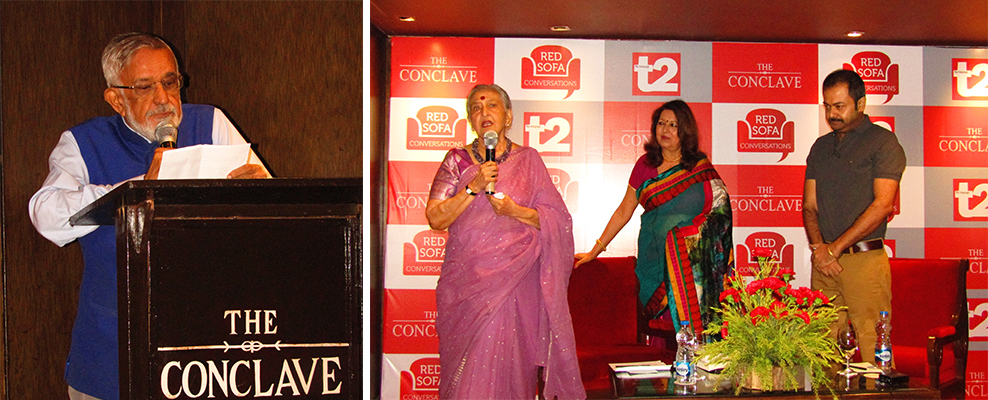The Red Sofa conversation, which is part of a series that happens regularly with celebrities from the world of art, films, literature, music, advertising, sport, had its seventeenth edition at The Conclave on Tuesday the 12th, over an elegantly crafted high tea. Bishwanath Ghosh was the man of the moment, author of Gazing at Neighbors: Travels Along the Line That Partitioned India, in conversation with Public Relations expert Rita Bhimani. The audience: an eclectic mix of educators, writers, publishers and people from the world of advertising, designing, entertainment.
The author is a full time journalist—associate editor with The Hindu in Chennai. His books have been mostly anecdotal and this current one goes one better, interweaving human interest tales of his travels along the infamous Radcliffe line, with a deep sense of history. The author has covered vast swathes of territory in both the western and eastern parts of this largely imaginative Radcliffe Line and garnered invaluable information from the locals living in “no man’s land.”
The sense we derived from the conversation was that he is not in the role of a historian seeking to open old wounds and tease out facts, but an empathetic traveler wanting to unearth real life tales of those living along the Radcliffe gash.
The session turned out to be greatly interactive. It started off with Professor Bharati Ray giving her take on the historical aspects and on the lucidity of the book. This was followed by actor-author Barun Chanda and writer-commentator Kishore Bhimani doing select readings from the book to give the audience a sense of the stories and the style of presentation.
For instance to show how the common man in Punjab never wanted war, Chanda brought to light a local restaurant owner talking about how one day his place would house a Museum of Peace, to celebrate Punjab—the undivided Punjab. And a quote from the author followed: “Reality, however, is as harsh as the scorching sun. No one had forcibly split Punjab: its people had voted to separate, Muslims on one side and Hindus and Sikhs on the other. Such was the animosity prevailing at the time. But once Partition was achieved, the animosity got blunted and anger was replaced with nostalgia. When you get nostalgic, you sometimes want to go back in time—only that barbed wires will now block your way.

Moving east, Kishore Bhimani read from the part which talked of the second wave of migration in the eastern part, in 1971 when East Pakistan fought its subjugation by West Pakistan. That was the year when nine million refugees had already poured into West Bengal, Assam, and Tripura—the Indian Army formally joined the Liberation War that the Mukti Bahini, the guerrilla force made up of Bengalis, was waging against the troops of West Pakistan. There was mention of a Sikh Brigadier, who trained the Mukti Bahini, but, who, on dismissal on account of irregularities, had joined forces with Bhindranwale. Bhimani talked of knowing the Brigadier who would come to his residence to partake of whiskies frequently. Author Bishwanath Ghosh’s observations cited after these readings were of great poignance: “Once the Indian forces marched in, the war was won in no time and East Pakistan became an independent nation called Bangladesh. Culture had prevailed over faith.”
Rita Bhimani then began the “conversation”, talking of how the book would have to vie for eyeball space with the many movies made recently on the subject, from Raj Kahini and Begum Jaan to Viceroy’s House. And when she brought in the latest book from England by on the Story of Indian Independence by Barney White-Spinner saying that the act of not quelling partition violence in 1947 was a ‘terrible mistake’, a young trainee journalist from that country got up and spontaneously and dramatically pleaded “Guilty”!
And so, to Bishwanath Ghosh’s narrative, particularly when he was questioned on his experiences at the Wagah border and in contrast his experiences at the other end, in Karimganj.
The author talked about his interaction with people as the Samjhauta Express came into Attari, about the meeting of soldiers from both sides at Wagah, where Indians and Pakistanis “spent hours practicing together to look like enemies at sunset”, about lesser known places like Hussainiwala, where Bhagat Singh and others were martyred; about Karimganj, where he suggested there could be a joint river ceremony, that could draw more tourists to the spot. Bishwanath has shown that history is a given. But it is the human interest stories that will abide with us, giving us a picture of the real India today. People living with scars of the past, but really going beyond the longings.
